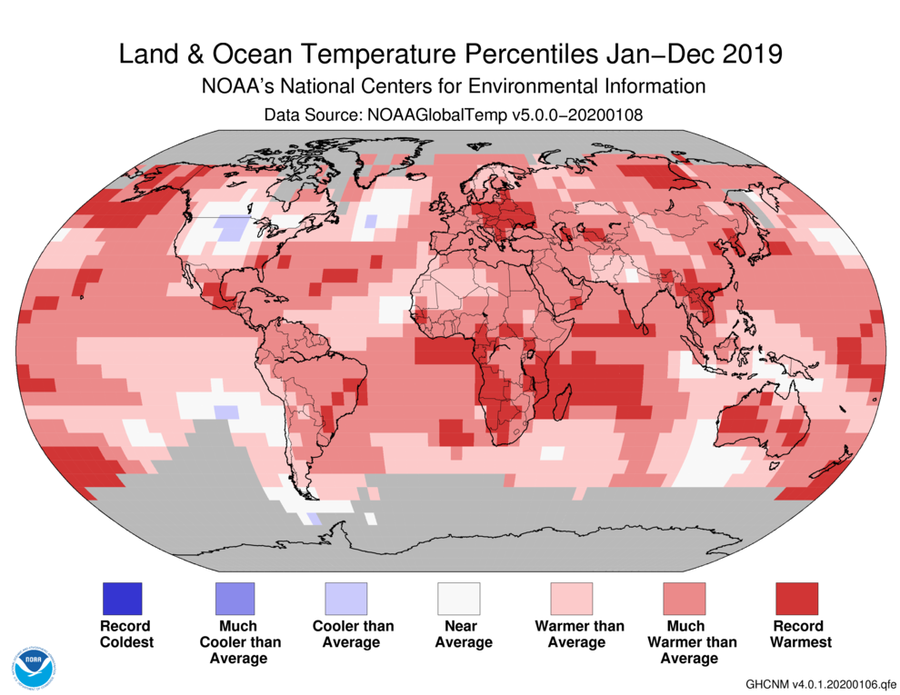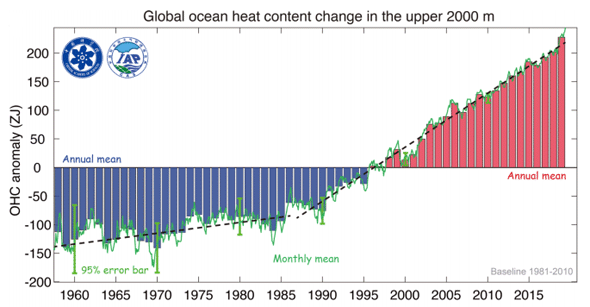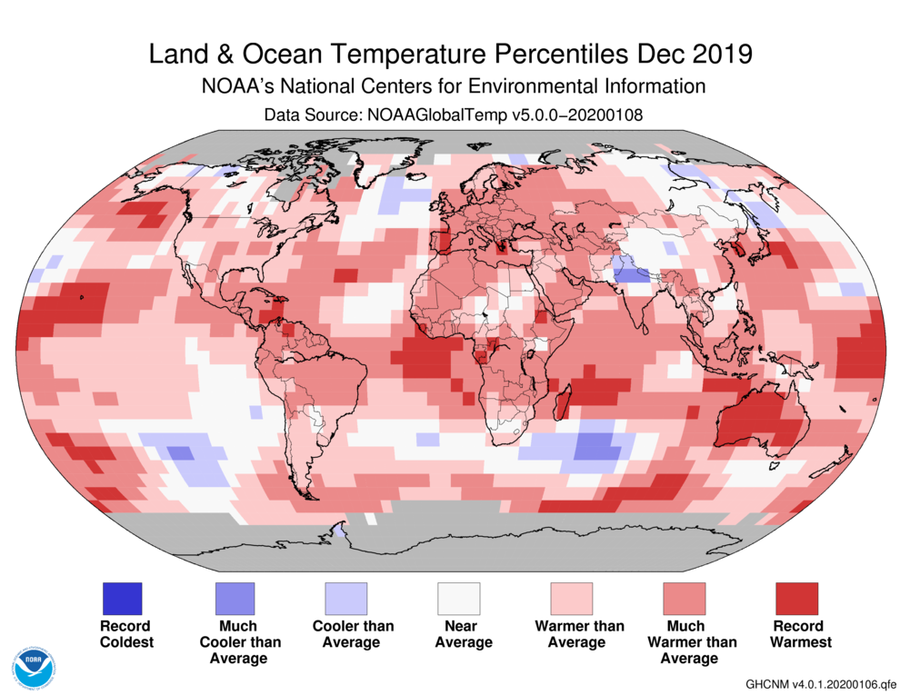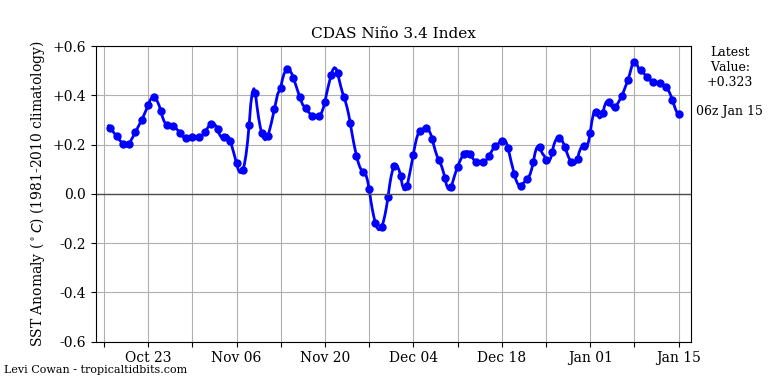This article was published in Scientific American’s former blog network and reflects the views of the author, not necessarily those of Scientific American
Earth had its second warmest year on record in 2019, just 0.04°C behind 2016, said NOAA and NASA on January 15. Global ocean temperatures and global land temperatures were both the second warmest on record. Global satellite-measured temperatures in 2019 for the lowest 8 km of the atmosphere were the third warmest or second warmest in the 42-year record, according to the University of Alabama Huntsville (UAH) and RSS, respectively.
By continent, here are the 2019 temperature rankings:
Australia (and Oceania): warmest year on record
Europe: 2nd warmest
South America: 2nd warmest
Asia: 3rd warmest
Africa: 3rd warmest
North America: 14th warmest
On supporting science journalism
If you're enjoying this article, consider supporting our award-winning journalism by subscribing. By purchasing a subscription you are helping to ensure the future of impactful stories about the discoveries and ideas shaping our world today.

Figure 1. Departure of temperature from average for 2019, the second warmest year the globe has seen since record keeping began in 1880, according to NOAA and NASA. Record high annual temperatures over land surfaces were measured across parts of central Europe, Asia, Australia, southern Africa, Madagascar, New Zealand, North America, and eastern South America. Record high sea surface temperatures were observed across parts of all oceans, specifically, parts of the North and South Atlantic Ocean, the western Indian Ocean, and areas of northern, central and southwestern Pacific Ocean. No land or ocean areas had record-cold temperatures in 2019. Credit: NOAA National Centers for Environmental Information (NCEI)
In the U.S., 2019 was the 34th warmest year on record, going back to 1895, but the year was the warmest on record for Alaska, North Carolina, and Georgia. As detailed in a January 8 post by Weather Underground’s Bob Henson, 2019 was the 2nd wettest year in U.S. history. Marathon, Florida, located about halfway between Key Largo and Key West, recorded an annual average temperature in 2019 of 81.7°F (27.6°C). “This beats by a very big margin every yearly temperature ever recorded in any of the 50 U.S. states,” said weather records expert Maximiliano Herrera.
The remarkable global warmth of 2019 means that the six warmest years on record since 1880 were the last six years—2014 through 2019. The near-record global warmth in 2019 is all the more remarkable since it occurred during the minimum of the weakest solar cycle in 100+ years, and during a year without a strong El Niño (though a weak El Niño was present in the first half of 2019, ending in July). Record-warm global temperatures typically occur during strong El Niño events, and when the solar cycle is near its maximum. The near-record warmth of 2019 is thus a testament to how greatly human-caused global warming is impacting the planet.

Figure 2. Upper 2000 m ocean heat content from 1955 through 2019. The histogram represents annual departure from average (units: ZJ), wherein positive anomalies relative to a 1981−2010 baseline are shown as red bars and negative anomalies as blue. The two black dashed lines are the linear trends over 1955–86 and 1987−2019, respectively. Credit: Cheng, L., and Coauthors, 2020: Record-setting ocean warmth continued in 2019. Adv. Atmos. Sci., 37(2), 137−142, https://doi.org/10.1007/s00376-020-9283-7
Warmest year on record for total ocean heat content
The total heat content of the world’s oceans (OHC) in 2019 was the warmest in recorded human history, according to a January 13 paper by Cheng et al., Record-Setting Ocean Warmth Continued in 2019, published in Advances in Atmospheric Sciences. In the uppermost 2000 meters of the oceans, there were 228 Zetta Joules more heat in 2019 than the 1981−2010 average; 2019 had 25 Zetta Joules more OHC than 2018 (a Zetta Joule is one sextillion Joules-- ten to the 21st power). “We found that 2019 was not only the warmest year on record, it displayed the largest single-year increase of the entire decade, a sobering reminder that human-caused heating of our planet continues unabated,” said Penn State’s Dr. Michael Mann, one of the co-authors. The gain in ocean heat between 2018 and 2019 was about 44 times as great as all the energy used by humans in one year.
More than 90% of the increasing heat from human-caused global warming accumulates in the ocean because of its large heat capacity. The remaining heating manifests as atmospheric warming, a drying and warming landmass, and melting of land and sea ice. The past ten years are the ten warmest years on record for total ocean heat content. Increasing OHC causes sea level rise through thermal expansion of the water and melting of glaciers in contact with the ocean, and contributes to “marine heat waves” that kill coral reefs and disrupt atmospheric circulation patterns.
A remarkable slew of high temperature records
International records researcher Maximiliano Herrera keeps the pulse of the planet in remarkable detail, and he logged 24 nations or territories that set or tied their all-time heat records in 2019, beating 2016 (with 22) for most such records. No nations or territories set or tied an all-time cold record in 2019. Among the global weather stations with a long period of record of at least 40 years, Herrera documented 632 that set (not tied) their all-time heat record; six of these stations did so twice in 2019, for a total of 638 exceedances of an all-time heat record. Just 11 stations with a long-term period of record set an all-time cold record in 2019.
Mr. Herrera’s computed the 2019 average temperature for each station by summing up and averaging daily temperatures, and came up with this list of the top five stations with the highest yearly average temperatures for 2019:
1: Matam, Senegal: 31.7°C (89.1°F)
2: Makkah Arafat, Saudi Arabia: 31.6°C (88.9°F)
3: Yelimane, Mali: 31.2°C (88.2°F)
3: Gizan, Saudi Arabia: 31.2°C (88.2°F)
5: Djibouti Ambouli, Djibouti: 31.1°C (88.0°F)
Here are the all-time records for highest yearly average:
1: Makkah, Saudi Arabia: 32.9°C (91.2°F) 2010, 2016
2: Nema, Mauritania: 32.8°C (91.0°F) 2010
3: Yelimane, Mali: 32.6°C (90.7°F) 2010
4: Hombori, Mali: 32.3°C (90.2°F) 2010
5: Kiffa, Mauritania: 32.2°C (90.0°F) 2010
5: Menaka, Mali: 32.2°C (90.0°F) 2010
Notable global heat and cold marks for 2019
Hottest temperature in the Northern Hemisphere: 53.1°C (127.6°F) at Shahdad, Iran, 2 July
Coldest temperature in the Northern Hemisphere: -60.5°C (-76.9°F) at GEOsummit, Greenland, 14 January
Hottest temperature in the Southern Hemisphere: 49.9°C (121.8°F) at Nullarbor, Australia, 19 December
Coldest temperature in the Southern Hemisphere: -82.7°C (-116.9°F) at Dome A, Antarctica, 15 June
(Courtesy of Maximiliano Herrera)
Twenty-three all-time national/territorial heat records set or tied in 2019
All-time high temperature records were tied or broken in 24 of the world’s nations and territories in 2019, beating 2016 (22 all-time heat records) for most prolific year on record for all-time national heat records, according to international records researcher Maximiliano Herrera; 2017 holds third place with 14 heat records. Here are 2019’s national heat records, with notations by Herrera at the end (note that there was also an all-time heat record set in Timor Leste of 38.5°C at Manauto, but no date was given for the measurement, and the record is not included in the list below):
Christmas Island (Australia): 31.6°C (88.9°F), 19 January
Reunion Islands (France): 37.0°C (98.6°F), 25 January
Angola: 41.6°C (106.9°F), 22 March
Togo: 43.5°C (110.3°F), 28 March (later tied on 4 April)
Vietnam: 43.4°C, (110.1°F), 20 April
Jamaica: 39.1°C (102.4°F) at Shortwood Teacher’s College, 22 June
France: 46.0°C (114.8°F) at Verargues, 28 June
Andorra: 39.4°C (102.9°F) at Borda Vidal, 28 June
Cuba: 39.1°C (102.4°F) at Veguitas (Cuba), 30 June
Jersey (crown dependency of Britain): 36.0°C (96.8°F) at Jersey Airport, 23 July (record tied)
Belgium: 41.8°C (107.2°F) at Begijnendijk, 25 July
Germany: 41.2°C (108.7°F) at Tonisvorst and Duisburg, 25 July*
Luxembourg: 40.8°C (105.4°F) at Steinsel, 25 July
Netherlands: 40.7°C (105.3°F) at Gilze Rijen, 25 July
United Kingdom: 38.7°C (101.7°F) at Cambridge, 25 July
Aland Islands: 31.6°C (88.9°F) at Jomala, 27 July
Norway: 35.6°C (96.1°F) at Laksfors, 27 July (record tied)**
Syria: 50.0°C (122.0°F) at Hasakah, 13 August***
Wake Island (United States Minor Outlying Islands): 36.6°C (97.9°F) at Wake Airfield, 15 August
Guadeloupe (French territory): 36.6°C (97.9°F) at Vieux Habitants, 9 September
Zimbabwe: 47.6°C (117.7°F) at Buffalo Range, 28 October
Malawi: 46.0°C (114.8°F) at Nsanje, 29 October (record tied)
Comoros: 36.0°C (96.8°F) at Hahaya Airport, 23 November (record tied)
* The official national record of 42.6°C measured the same day at Lingen is irregular and totally incompatible with nearby stations data and with the atmospheric conditions. The station has a history of overexposure and of being unreliable and is set to be moved. Despite this, the record was made official by the German DWD. Estimated overexposure is estimated to be about 2°C.
** This tied record was dismissed by the Norwegian Met. Service on weak grounds despite being reliable and compatible with nearby stations data and the atmospheric conditions. Confoundingly, the totally unreliable and irregular records set in August 1901—30 years before the installment of the first reliable temperature shelter with a Stevenson Screen in Oslo—have not been dismissed.
*** The Hasakah, Syria station has 1°C precision. The max temperature of 50.0°C is supported by nearby stations, so the record can be accepted.
No all-time national cold records were set in 2019. Most nations do not maintain official databases of extreme temperature records, so the national temperature records reported here are in many cases not official. If you reproduce this list of extremes, please cite Maximiliano Herrera as the primary source of the weather records. Jérôme Reynaud also tracks all-time and monthly national extreme temperature records at geoclimat.org (in French language).
One hundred thirty-five additional monthly national/territorial heat records beaten or tied in 2019
In addition to the 24 all-time any-month heat records listed above, 135 national monthly records were also beaten or tied in 2019. If we add together these totals, there were 159 monthly national/territorial heat records beaten or tied in 2019; two monthly cold records were set (in August in Svalbard and in May in Singapore). Here are the monthly all-time national heat records for 2019:
January (5): Micronesia, Paraguay, Angola, Equatorial Guinea, Palau
February (19): Chile, Marshall Islands, Guyana, United Kingdom, Denmark, Sweden, Netherlands, Belgium, Luxembourg, Andorra, Austria, Hungary, Jersey, Guernsey, Slovakia, San Marino, Slovenia, Angola, Papua New Guinea
March (5): Australia, Marshall Islands, India, Kenya, Northern Marianas
April (7): Angola, Togo, French Southern Territories, Mayotte, Taiwan, Kenya, Mauritius
May (12): Kenya, Indonesia, Niger, French Southern Territories, Syria, Tonga, Laos, Vietnam, Japan, Israel, Cyprus, Turkey
June (17): India, Tonga, Namibia, Lithuania, Senegal, Qatar, Chile, Laos, Vietnam, Germany, Czech Republic, Poland, Switzerland, Luxembourg, Liechtenstein, St. Barthelemy, Monaco
July (10): Iran, Wallis and Futuna, Namibia, Jordan, Israel, Hong Kong, Chile, Bonaire, Mauritius, Guadeloupe
August (5): Taiwan, Cape Verde, Namibia, Wallis and Futuna, Kenya
September (13): Oman, Brunei, Niger, Saba, Nicaragua, Paraguay, Brazil, Solomon Islands, Morocco, Comoros, Laos, Jamaica, Kenya
October (16): Hong Kong, Mongolia, Morocco, Micronesia, Qatar, Kuwait, North Korea, China, Saba, Thailand, Mozambique, Botswana, Falkland Islands, South Georgia and Sandwich Islands, French Southern Territories, Singapore
November (11):St Pierre et Miquelon, Haiti, Syria, Tuvalu, Antigua and Barbuda, Reunion Island, South Africa, Namibia, Thailand, Liberia, Singapore
December (15): Indonesia, Iceland, Australia, Cuba, India, Chile, Liberia, Guinea Bissau, Saba, UK, Mexico, Fiji, French Southern Territories, Mayotte, Mauritius
(Courtesy of Maximiliano Herrera)
Hemispheric and continental temperature records in 2019
- Highest minimum temperature ever recorded in the Southern Hemisphere: 35.9°C (96.6°F) at Noona, Australia, 18 January. The record was beaten again on 26 January, with a minimum temperature of 36.6°C (97.9°F) recorded at Borrona Downs, Australia. This is also the highest minimum temperature on record for the globe for the month of January.
-Highest temperature ever recorded in March globally: 48.5°C (91.4°F) at Emu Creek, Australia, on 11 March.
- Highest temperature ever recorded in Asia in March: 46.9°C (116.4°F) at Kapde, India, 25 March. The data comes from a state (not central government) station, and may not be officially recognized, but is supported by data from several nearby stations.
- Highest minimum temperature ever recorded in June in the Southern Hemisphere: 28.9°C (84.0°F) at Funafuti, Tuvalu on 15 June.
- Highest minimum temperature ever recorded in August in the Southern Hemisphere (tie): 28.2°C (82.8°F) at Funafuti, Tuvalu on 15 August.
- Highest temperature ever recorded in October in the Northern Hemisphere: 47.6°C (117.7°F) at Al Wafra, Kuwait on 3 October.
- Highest minimum temperature ever recorded in October globally: 33.0°C (91.4°F) at Sedom, Israel on 15 October.
- Highest temperature ever recorded in Africa in November: 47.5°C (117.5°F) at Vioolsdrif, South Africa on 27 November (starting from 28 November, the station started giving incorrect temperatures, but the Nov 27th record was fully confirmed by an almost identical temperature at the Noordower station, a few miles from Vioolsdrif).
- Highest temperature ever recorded in December globally: 49.9°C (121.8°F) at Nullarbor, Australia on 19 December
- Highest minimum temperature ever recorded in December globally: 36.0°C (96.8°F) at Wallungurry, Australia on 26 December

Figure 3. Departure of temperature from average for December 2019, the second warmest December for the globe since record keeping began in 1880, according to NOAA and NASA. Record-warm December temperatures were observed across most of Australia and across parts of the Indian Ocean, Africa, Europe, the Atlantic Ocean, and the northern and western Pacific Ocean. No land or ocean areas had record-cold December temperatures. Credit: NOAA National Centers for Environmental Information (NCEI)
December 2019: Earth’s Second Warmest December on Record
December 2019 was the planet's second warmest December since record keeping began in 1880, said NOAA's National Centers for Environmental Information (NCEI) on January 15. NASA also rated December 2019 as the second warmest December on record, a scant 0.05°C behind the record-setting December 2015, when a strong El Niño event was in progress.
Global ocean temperatures during December 2019 were the second warmest on record, according to NOAA, as were global land temperatures. Global satellite-measured temperatures in December 2019 for the lowest 8 km of the atmosphere were the warmest in the 42-year record, according to the University of Alabama Huntsville (UAH) and RSS.
Neutral El Niño conditions reign
NOAA’s January 9 monthly discussion of the state of the El Niño/Southern Oscillation (ENSO) stated that neutral ENSO conditions existed, with neither an El Niño nor a La Niña event in progress. Over the past month, sea surface temperatures (SSTs) in the benchmark Niño3.4 region of the eastern tropical Pacific were near the 0.5°C above-average threshold need to be considered El Niño conditions, though. A strong westerly wind burst (WWB) near the Dateline was in progress this week, which will help keep the ocean close to the El Niño threshold. Most climate models predict that sea surface temperatures in the Niño3.4 region will stay near the El Niño threshold into March before decreasing to near-average levels by late spring.
Forecasters at NOAA and the International Research Institute for Climate and Society (IRI) are calling for a roughly 60% chance of neutral conditions continuing through the Northern Hemisphere spring, and a 50% chance of neutral conditions continuing through the summer of 2020. They put the odds of an El Niño event forming by spring at about 30%; the odds of a La Niña event were less than 10%. For the August-September-October peak portion of hurricane season, the odds of El Niño and La Niña being given were roughly equal, between 25 – 30%.

Figure 4. Departure of sea surface temperatures (SSTs) in the benchmark Niño 3.4 region (in the equatorial Pacific) ending on January 15, 2020. Over the past month, SSTs were 0.1 - 0.5°C above average, falling short of the 0.5°C above-average threshold need to be considered El Niño conditions. Credit: Levi Cowan tropicaltidbits.com
December Arctic sea ice extent: fifth lowest on record
According to the National Snow and Ice Data Center (NSIDC), Arctic sea ice extent during December was the fifth lowest in the 41-year satellite record. By the end of December, daily sea ice extent was the seventh lowest on record, and the highest since December 2014.
In Antarctica, sea ice extent in December 2019 was also the fifth lowest for December since satellite records began in 1979.
Notable global heat and cold marks for December 2019
Hottest temperature in the Northern Hemisphere: 40.4°C (104.7°F) at Tambacounda, Senegal, 1 December
Coldest temperature in the Northern Hemisphere: -56.7°C (-70.1°F) at GEOSummit, Greenland, 10 December
Hottest temperature in the Southern Hemisphere: 49.9°C (121.8°F) at Nullarbor, Australia, 19 December
Coldest temperature in the Southern Hemisphere: -43.2°C (-45.8°F) at Dome A, Antarctica, 2 December
(Courtesy of Maximiliano Herrera)
Major weather stations that set (not tied) all-time heat or cold records in December 2019
Among global stations with a period of record of at least 40 years, 31 set new all-time heat records in December. There were no stations that set all-time cold records.
Kowanyama (Australia) max. 41.9°C, 3 December
Eucla (Australia) max. 49.8°C, 19 December
Ceduna (Australia) max. 48.9°C, 19 December
Hawker (Australia) max. 46.1°C, 19 December
Coober Pedy (Australia) max. 48.3°C, 20 December
Keith (Australia) max. 47.8°C, 20 December
Lameroo (Australia) max. 48.4°C, 20 December
Mount Gambier (Australia) max. 45.9°C, 20 December
Coonawarra (Australia) max. 45.8°C, 20 December
Naracoorte (Australia) max. 47.7°C, 20 December
Padthaway (Australia) max. 46.1°C, 20 December
Cape Nelson (Australia) max. 45.1°C, 20 December
Loxton (Australia) max. 47.3°C, 20 December
Renmark (Australia) max. 48.6°C,20 December
Cape Otway (Australia) max. 43.4°C, 20 December
Portland Airport (Australia) max. 43.6°C, 20 December
Hamilton (Australia) max. 45.0°C, 20 December
Nowra (Australia) max. 45.6°C, 21 December
Goulburn Aiport (Australia) max. 42.1°C, 21 December
Young (Australia) max. 44.1°C, 21 December
Sandy Cape (Australia) max. 36.0°C, 22 December
Glen Innes (Australia) max. 37.3°C, 22 December
Rapel (Chile) max. 38.4°C, 23 December
Juan de Nova Island (French Southern Territories, France) max. 35.4°C, 24 December
Giles (Australia) max. 46.8°C, 25 December
Alice Springs (Australia) max. 45.7°C, 25 December
Rabbit Flat (Australia) max. 47.9°C, 25 December
Daly Waters (Australia) max. 45.6°C, 27 December
Bage (Brazil) max. 41.1°C, 28 December
Sao Gabriel (Brazil) max. 41.2°C, 28 December
Hobart Airport (Australia) max. 40.8°C, 30 December
(Courtesy of Maximiliano Herrera)